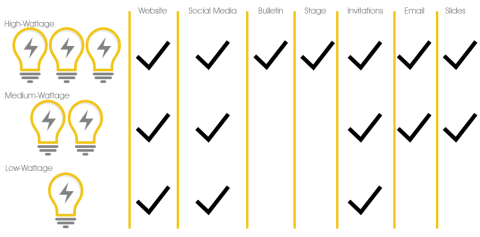Stop Announcing Everything
0 comments
1441 views

It’s one of the most universal issues that church communicators face. I see the same dilemma arise in every church I visit — how do we rank what gets communicated, using which methods? I think I can give your church a few insights to help you get the ball rolling in prioritizing what gets communicated where.
THE ISSUE
When I talk about prioritizing church communications, what I mean is having a plan in place to help you navigate the murky marketing waters.
Without a plan, everything gets announced everywhere — or worse, nowhere. Without having a plan in place, it is easy to overlook an event or announcement for something else that has taken up so much of your time.
When there is no plan in place, your ministry leaders and communications tend to focus all the attention on one medium that becomes the “make or break” announcement platform for their event — usually it’s stage announcements. And when we put all our eggs in one basket, focusing all our attention on one medium to get the word out, every announcement begins to bombard the audience, meaning nothing is heard.
Without a clear emphasis of communications, all we communicate becomes a boring beating drone week after week.
PRIORITIZING EVENTS
When an event comes across your desk (event meaning anything that needs to be announced — a communication event) there are three questions to ask:
A THREE-TIERED APPROACH
To help you prioritize what gets communicated through different avenues, set up a three-tiered approach to church communications. The tier a communication event goes in depends on how much of the church the event applies to and how the event would best be communicated.
In keeping with the Church Juice theme of energizing church communications, I chose to go with the term “wattage” to help you get a better grasp. More wattage means more energy, time, and communication avenues.
HIGH-WATTAGE EVENTS
A high-wattage event is the highest level of communication. This should be an event that applies to the whole congregation, or at least 85% of your regular attendees. These are events that everyone needs to hear about. Some good examples of a high-wattage event would be Christmas or Easter services, something related to the vision of the church, next steps that apply to everyone (small groups launching), or a new sermon series starting next week.
High-wattage events require the most energy. They are the events that should be promoted and talked about across all of your church’s methods of communication.
MEDIUM-WATTAGE EVENT
Most events should fall into the medium-wattage event category. This applies to many in the church, but not everyone. A general rule of thumb would be events that apply to 35%-85% of your Sunday attendees. These would be events like baptisms, large ministry events, next steps, or giving.
Medium-wattage events do not need to be promoted across every platform or medium, but should be focused on where they will be most effective.
LOW-WATTAGE EVENT
The lowest level of a church communicator’s investment should go into low-wattage events. These are events that apply to less than a third of your congregation, and are pretty specific to certain crowds or ministries. For example, an event applying to new guests, an upcoming children’s event, or a time change for a certain bible study.
Low-wattage events should be communicated sparingly, advertised using only the venues that make sense for the announcement.
SETTING UP YOUR TIERS
Your church may need to apply these general terms differently to better meet the needs you face. What’s important is to realize that there needs to be a central location where people can access information for any event, regardless of what tier it falls into. For many churches, this would be the church website. For others, it may be the bulletin, or even a physical location in the church lobby. Decide where your central hub is going to be, and make sure you point people there to access any information they need to acquire at any time for any event.
After you decide what the central hub of information is going to look like for your church, you can begin to set up your tiered system. Decide what platforms make the most sense for each tier, and how that applies to various situations that you come across on a regular basis. Set up your communication tiers as a guide — not a set of rules, but a method to help guide your decisions.
Remember — you’re changing church culture. So be patient, understanding, and don’t be quick to make rapid changes. Get the necessary people on board and begin to make incremental changes so you can communicate to your people more effectively without sounding like a boring drone.
Church Juice is a ministry of the CRCNA, focused on helping congregations energize their marketing and communications. For more from Church Juice, and to subscribe for the latest, click here.

Church Communications
Church Communications
Council, Church Communications
CRCNA and Synod, Church Communications
Connect to The Network and add your own question, blog, resource, or job.
Add Your Post
Let's Discuss
We love your comments! Thank you for helping us uphold the Community Guidelines to make this an encouraging and respectful community for everyone.